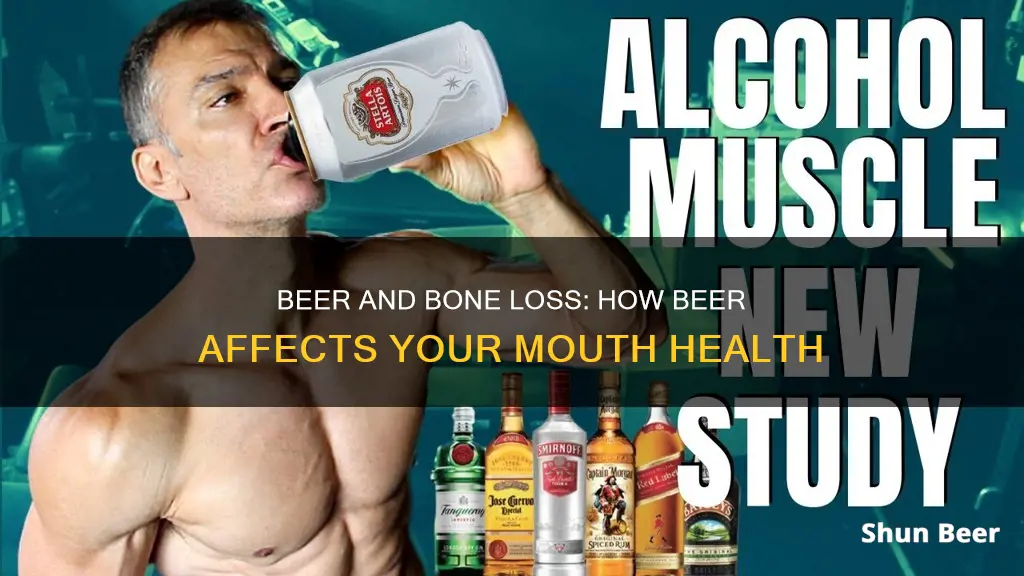
Alcohol is known to have detrimental effects on oral health, but can drinking beer cause bone loss in your mouth? Beer is crafted by brewing a cereal grain that then ferments to become alcohol and is carbonated, making it acidic. The carbonation in beer can quickly turn into carbonic acid in your mouth, which wears away at your teeth's enamel. Over time, as you drink more acidic beverages like beer, your teeth can face a serious threat of enamel loss, which can lead to tooth sensitivity and cavities. Beer is also packed with sugars, and those sugars can be damaging to your teeth as they stick to your teeth and are then consumed by the natural bacteria found in your mouth. These bacteria then secrete acids that eat away at the enamel on your teeth, making them susceptible to decay. In addition, just like coffee and cola, dark beers can stain your teeth's enamel, leading to discoloration.
| Characteristics | Values |
|---|---|
| Effect on bone density | Alcohol consumption can decrease bone density and increase the risk of fracture. |
| Effect on bone tissue | Alcohol can interfere with the replacement of bone tissue, disrupting the balance between the erosion and remodeling of bone tissue. |
| Effect on osteoblasts | Alcohol inhibits osteoblastic cell proliferation and activity, resulting in decreased bone formation. |
| Effect on osteoclasts | Alcohol may increase osteoclast resorption, but its effect on bone-resorbing cells is uncertain. |
| Effect on hormones | Alcohol can disrupt the hormones that regulate calcium metabolism, such as parathyroid hormone and vitamin D. |
| Effect on tooth enamel | Beer is acidic and can wear away tooth enamel, leading to tooth sensitivity and cavities. |
| Effect on tooth decay | Alcohol can increase the risk of tooth decay by decreasing saliva production and providing fuel for bacteria that break down enamel. |
| Effect on oral bacteria | Alcohol promotes the growth of harmful bacteria in the mouth while inhibiting beneficial probiotic bacteria. |
| Effect on oral cancer risk | Alcohol abuse is the second most common risk factor for oral cancer. |
What You'll Learn
- Beer is acidic and can cause enamel loss
- Alcohol can cause dehydration, reducing saliva production and increasing the risk of tooth decay
- Dark beers can stain teeth
- Alcohol negatively impacts bone health by affecting nutrient absorption
- Alcohol abuse is the second most common risk factor for oral cancer

Beer is acidic and can cause enamel loss
Beer is indeed acidic and can cause enamel loss. The carbonation in beer can quickly turn into carbonic acid in your mouth, which wears away at your teeth's enamel. Beer has an average pH of between 4.0 and 5.5, which is below the critical pH of 5.7 below which enamel demineralization can occur. This means that the acid from the beer is eating away at the protective enamel on your teeth. Over time, as you drink more acidic beverages like beer, your teeth can face a serious threat of enamel loss, which can lead to dental problems like tooth sensitivity and cavities.
Because enamel is not a living substance, once it is lost or worn down, your body cannot replenish or repair it. Any enamel issues can only be addressed by a dentist. In addition to the acidity, the sugars in beer can also be damaging to your teeth. Sugar sticks to your teeth and is then consumed by the natural bacteria in your mouth, which then secrete acids that eat away at the enamel.
To prevent enamel loss, it is recommended to drink water while enjoying beer to help wash the beer off your teeth. It is also important to brush your teeth soon after finishing your beer, especially if it is a dark beer, as these can cause stains and discoloration. Keeping up with regular dental cleanings is another way to ensure that beer drinking is not affecting your smile.
Antihistamines and Alcohol: Safe to Mix?
You may want to see also

Alcohol can cause dehydration, reducing saliva production and increasing the risk of tooth decay
Alcohol is a diuretic, which means it causes the body to produce more urine, potentially leading to dehydration. This dehydration caused by alcohol consumption can result in reduced saliva production, a condition known as dry mouth or xerostomia.
Saliva is critical for maintaining oral health, as it helps to wash away harmful acids and bacteria that can cause tooth decay. When there is less saliva in the mouth, bacteria can cling to the teeth, increasing the risk of cavities and other forms of tooth decay.
Additionally, alcohol can irritate and inflame the tissues in the mouth and throat, further reducing saliva production. This reduction in saliva flow can lead to symptoms such as a dry or sticky feeling in the mouth, difficulty swallowing, and a sore throat.
To minimise the harmful effects of alcohol on oral health, it is recommended to sip water between alcoholic drinks to stay hydrated and replenish saliva. Brushing, flossing, and using mouthwash after consuming alcohol can also help prevent tooth decay and maintain oral hygiene.
Hot Beer: To Drink or Not to Drink?
You may want to see also

Dark beers can stain teeth
Drinking beer can have several effects on your oral health. Beer is acidic, with an average pH of between 4.0 and 5.5, which can lead to enamel demineralization and erosion. The carbonation in beer can turn into carbonic acid in your mouth, wearing away at your teeth's enamel. Over time, drinking beer can lead to tooth sensitivity and cavities.
Dark beers, such as stouts, are brewed with a small proportion of darker malt to achieve their shade. Colourants such as caramel are also used to darken beers. These dark beers can stain your teeth, leading to discoloration, especially if consumed regularly. The barley and malts used to brew darker beers can turn your teeth into a dull gray over time.
To avoid tooth discoloration from drinking dark beers, you can try using a straw or rinsing your mouth with water after drinking. Brushing your teeth soon after finishing your beverage is also recommended.
Drinking Beer in Public: Italian Laws and Culture
You may want to see also

Alcohol negatively impacts bone health by affecting nutrient absorption
Vitamin D plays a vital role in bone health by promoting calcium absorption in the intestines. Alcohol can hinder this process by interfering with the activation of vitamin D, leading to reduced calcium absorption. This interference can have detrimental effects on bone density and overall bone health.
Additionally, alcohol abuse has been linked to hormone deficiencies, particularly a decrease in testosterone levels in men and a reduction in estrogen levels in women. These hormones play a significant role in bone metabolism and bone mass. Estrogen, for example, can inhibit bone breakdown and may stimulate bone formation. Therefore, a decrease in estrogen levels during menopause or due to alcohol abuse can contribute to bone loss.
The impact of alcohol on nutrient absorption and hormone levels can have a cascading effect on bone health. It can disrupt the balance between bone erosion and remodelling, leading to conditions like osteoporosis and an increased risk of fractures.
Furthermore, alcohol consumption can also affect bone health by influencing the activity of osteoblasts and osteoclasts, which are cells responsible for bone formation and resorption, respectively. Alcohol has been found to inhibit osteoblast activity, resulting in impaired bone formation and mineralization. This inhibition can lead to a decrease in bone mass and strength, making bones more prone to fractures.
While the effects of moderate drinking on bone health are still being studied, chronic heavy drinking has consistently been linked to negative outcomes. The negative impact of alcohol on nutrient absorption, hormones, and bone-forming cells underscores the importance of drinking in moderation and maintaining a healthy lifestyle to support bone health.
Beer and Bowel: Friend or Foe?
You may want to see also

Alcohol abuse is the second most common risk factor for oral cancer
Alcohol consumption increases the risk of developing oral cavity and oropharyngeal cancers. The more alcohol a person drinks, the higher their risk of developing oral cancer. Heavy drinkers have a higher risk than light drinkers, with heavy drinking defined as having four or more drinks in a day or eight or more drinks per week for women, and five or more drinks in a day or 15 or more drinks per week for men. Moderate drinkers have a 1.8-fold higher risk of oral cavity cancers compared to non-drinkers, while heavy drinkers have a five-fold higher risk.
The combination of alcohol and tobacco use has a multiplicative effect on the risk of oral cancer. The risk of oral cancer in people who drink heavily and smoke is about 30 times higher than in those who don't drink or smoke. Tobacco use is one of the strongest risk factors for oral cancer, and most people with oral cancer have a history of tobacco exposure. The commonest form of tobacco use is smoking, but oral tobacco products like snuff, dip, and chew are linked with cancers of the cheek, gums, and inner surface of the lips.
Alcohol may facilitate the entry of carcinogens into exposed cells and alter the metabolism of oral mucosal cells. It can also cause dehydration, decreasing saliva production and allowing harmful bacteria to cling to teeth, increasing the risk of tooth decay and cavities. Additionally, the sugars in alcoholic beverages can damage tooth enamel, and dark-coloured drinks can cause staining.
While the exact mechanism is not fully understood, researchers have hypothesized that alcohol increases the risk of cancer by metabolizing ethanol into acetaldehyde, a toxic chemical and probable human carcinogen. Alcohol can also generate reactive oxygen species, which can damage DNA, proteins, and lipids in the body through oxidation.
It is important to note that alcohol abuse can have serious consequences for oral health and overall health. The federal government's Dietary Guidelines for Americans recommend that individuals who do not drink alcohol should not start, and those who do drink should limit consumption to no more than two drinks per day for men and one drink per day for women.
Drinking Beer with Propranolol: What You Need to Know
You may want to see also
Frequently asked questions
Drinking beer can contribute to bone loss in the mouth, particularly when consumed in excess. Beer's acidity can lead to enamel demineralization and erosion, making teeth more susceptible to decay and cavities.
Beer is acidic and has a pH between 4.0 and 5.5. This acidity can dissolve the protective enamel on your teeth, a process known as enamel demineralization. The carbonation in beer can turn into carbonic acid, further contributing to enamel erosion.
Yes, age is a factor. Long-term alcohol consumption starting from adolescence can reduce peak bone mass, resulting in weaker adult bones that are more prone to fractures. Additionally, drinking darker beers can stain the enamel, leading to discoloration over time.
It is important to practice good oral hygiene and maintain proper oral care. This includes alternating between drinking beer and water to help wash away sugars and acids that contribute to cavities and tooth decay. Brushing your teeth after consuming beer can also help prevent enamel erosion and discoloration.
Beer contains calcium and has antibacterial properties due to its yeast and good bacteria content. However, the benefits of these components may be outweighed by the negative effects of beer's acidity and sugar content on oral health.







